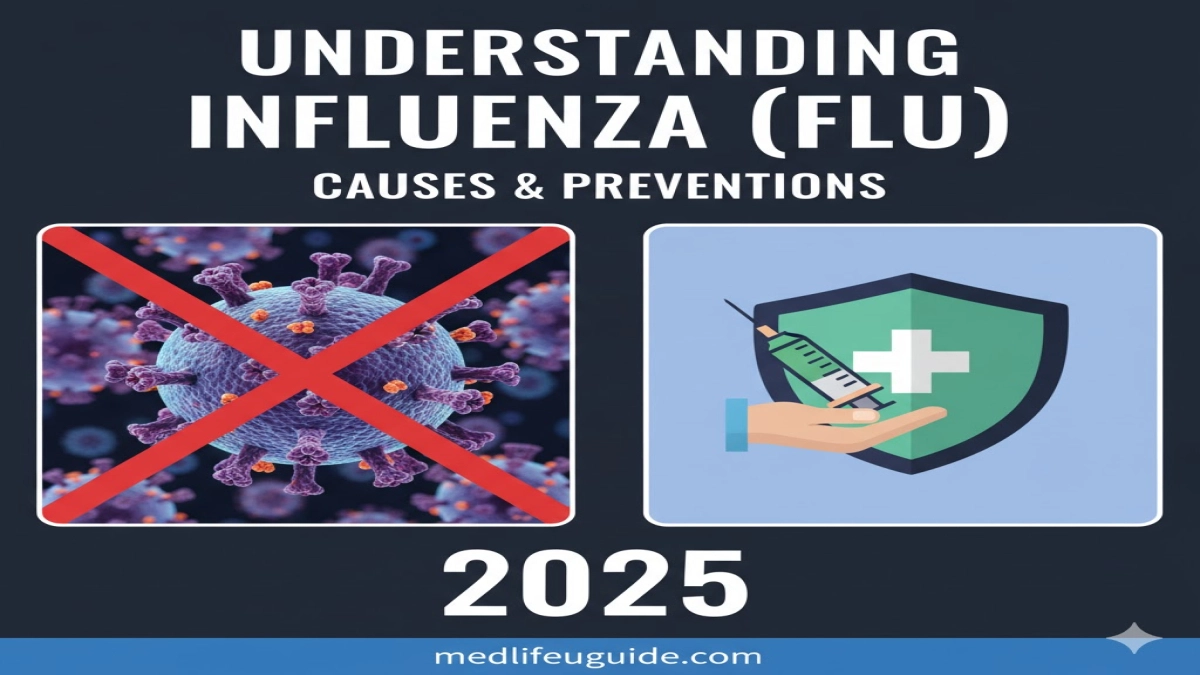In this article I’ll walk you through how the flu virus works, why you catch it, which “latent” fears people often have, and exactly what you can do to reduce your risk. We’ll cover causes, transmission, high-risk groups, and prevention—from daily habits to vaccine strategy. I’ll also highlight where you should dig deeper (for example, linking to a page on vaccine options or one on antiviral treatments).
Let’s dive in.
What is Influenza?
First, a quick refresher: the flu is an infection of the respiratory tract, caused by a variety of influenza viruses, primarily types A and B. Unlike the “stomach flu” (which is something else entirely), this affects your nose, throat and sometimes lungs.
What’s important: each season the dominant strains shift. The virus mutates (a process called antigenic drift for minor changes, and shift for major ones) meaning last year’s immunity may not fully cover this year. That’s why prevention must keep evolving.
Why “causes” matter
When we say “cause,” we’re not only talking “which virus ?” but “why did I catch it ?” and “what enabled it to spread ?” By understanding those root factors you’re in a better position to stop it ahead of time.
Why “prevention” is more than just one shortcut
Prevention isn’t just “get the shot.” It’s about habits, environment, awareness of risk, plus vaccination. The phrase “latent user queries” we need to answer includes things like: “Am I safe if I’m vaccinated but still go to big crowds?”, “What extra steps when kids are in school?”, “Is it too late to vaccinate?”, “What if I have an underlying condition?” This piece will address those.
How the Flu Spreads (Transmission & Cause)
Understanding the chain of transmission is key. If you know where weak links are, you can reinforce them.
Viral modes
- The primary mode is respiratory droplets. When someone with the flu coughs, sneezes or even talks, droplets travel to nearby noses, mouths, or are inhaled.
- A secondary mode: touching surfaces contaminated with flu virus, then touching your eyes, nose or mouth.
- Incubation time: typically about 1-4 days from infection to symptoms, with the person already contagious during much of that window.
Why some people spread more widely than others
- Someone who’s sick but still going about daily life (school, work) materially increases spread.
- Settings with many people in close contact (offices, schools, public transit) create “super–spread” opportunities.
- Indoor air quality, poor hygiene practices and low immunity all contribute.
- Mutations in the virus that make it more transmissible or less covered by vaccine raise overall risk.
“Root cause” factors at the individual level
Here are some hidden drivers:
- Low immunity (due to age, chronic illness, stress, poor sleep) means you’re more likely to get infected and more likely to transmit.
- Being around children (who often shed virus more easily).
- Complacency about hygiene (e.g., not washing hands, sharing utensils).
- Being in high-density environments (public transit, crowded classrooms).
- Unvaccinated status.
So when we talk “causes” in 2025, we’re talking: virus + environment + host susceptibility.
That triple combination is what drives whether you fall sick and how far the illness spreads.
Why Some People Get Worse Illness (Risk Factors)
It’s not just “you get the flu or you don’t.” Some people get mild flu and recover in a week; others end up hospitalized. Knowing who is at risk helps you act accordingly.
High-risk groups
- Very young children (6 months – 5 years) and especially those under 6 months who can’t yet be vaccinated.
- Older adults (65 +).
- People with chronic conditions: lung disease, heart disease, diabetes, immune-suppression.
- Pregnant people.
- Those living in long-term care facilities or close quarters.
Why this happens
- Their immune systems may not mount a full response, meaning the virus replicates more.
- They may already have weakened lung or organ reserve, so the infection tips them into complication (like pneumonia).
- Secondary bacterial infections become more likely.
What latent questions get asked:
- “If I’m healthy, am I safe?” — Not entirely. Healthy people catch and spread flu, though they often fare better.
- “If I have chronic illness but got vaccinated, am I fine?” — Vaccination helps but doesn’t eliminate risk; layered prevention is wise.
- “When is peak risk?” — Typically when flu is circulating actively (in many regions late fall through early spring) but anytime a new strain surfaces could shift timing.
Prevention Strategies for 2025 (What Works)
Now we get to actionable. Prevention is where we shift from “you could” to “you should.” I’ll list and then break down each major strategy—including those that are often overlooked.
Key bullets (overview)
- Annual vaccination.
- Habitual hygiene practices (hand washing, cough etiquette).
- Environmental steps (ventilation, surface cleaning).
- Behavioral modifications (staying home when sick, avoiding crowds).
- Health-supporting lifestyle (sleep, nutrition, stress management).
- Awareness of vaccine timing, strain updates, and adjusting plans for high-risk groups.
Let’s unpack them.
Annual vaccination
This remains the cornerstone. According to Centers for Disease Control and Prevention (CDC), the best way to prevent seasonal illness and serious complications is to get vaccinated each year.
Why each year? Because the circulating virus strains evolve and vaccine composition is updated accordingly.
Some specifics for 2025-26 (depending on region):
- Vaccines for use include trivalent (three-component) formulations.
- Even if you get vaccinated and still catch the illness, the vaccine often reduces severity and lowers risk of hospitalization.
(Suggestion: Insert local data from your country/region about vaccine uptake or strain match here to strengthen authenticity.)
Habitual hygiene practices
This is where “basic” often gets undervalued. But in practice, these steps make big difference. According to CDC:
- Wash hands often with soap and water (or use alcohol-based hand rub).
- Cover coughs/sneezes (into elbow or tissue).
- Avoid touching your eyes, nose and mouth with unclean hands.
- Stay home when you’re sick (and until you have been fever-free for at least 24 hours without medication) to reduce spread.
Environmental & behavioural controls
- Clean frequently touched surfaces (doorknobs, keyboards, phones) as viruses can live on surfaces.
- Improve air flow/ventilation. Outdoor air or well-ventilated indoor spaces reduce risk.
- In settings where many people gather, consider mask use (especially if local risk is high).
- Avoid close contact with people who are sick; keep a small social “buffer” if possible.
Healthy lifestyle supports
This often gets neglected but supports your “host” side of the equation (your body’s ability to resist infection).
- Get regular sleep. Being fatigued reduces immune responsiveness.
- Eat a nutrient-rich diet (fruits, vegetables, lean protein).
- Stay active.
- Manage stress (because chronic stress weakens immunity).
- Stay hydrated.
While none of these guarantee you won’t catch the flu, they improve your resiliency—so if you do get it, your body is better prepared. (This would be a great place to include a brief anecdote: “Last year I noticed when I skipped sleep three nights in a row I got sick after exposure…”)
Tailored strategy for high-risk groups
If you or someone you care for falls into a high-risk category (older adult, pregnant, chronic illness, young child) you need an extra layer of vigilance:
- Ensure vaccination includes the proper formulation for the high-risk category (e.g., high-dose vaccine for 65+).
- Consider early engagement with a health professional at the first sign of flu symptoms (because complicated cases need antiviral treatment).
- Avoid gatherings during known peak periods of flu activity, if possible.
- Encourage those around high-risk individuals to vaccinate (so you create a protective “bubble”).
How to Recognize It Early & Respond (Solving the Problem)
Prevention is ideal. But you also need to know how to act if you suspect you might be infected—so you limit spread and reduce severity.
Early signs
- Sudden onset of symptoms: fever, chills, muscle/body aches, headache, sore throat, cough, runny or stuffy nose.
- In children especially, sometimes vomiting and/or diarrhea.
- The key: it tends to come on more rapidly and intensely than a common cold.
What to do
- Stay home. Don’t go to work/school till you’ve been fever-free (without medication) for 24 hours and your symptoms are improving.
- Rest and hydrate. Your body needs energy to fight the infection.
- If you’re in a high-risk group (see above), contact your healthcare provider about antiviral treatment—early use (within ~48 hours) tends to be more effective.
- Practice good cough/sneeze hygiene and isolate (to the extent possible) from household members, especially if they’re high-risk.
- Monitor for signs of complications: worsening shortness of breath, chest pain, confusion, persistent fever, blue lips/skin. These are red flags.
Common Myths & Misconceptions (And What the Truth Is)
Let’s bust the ones you’ll hear often. Clearing these up builds trust and credibility.
- Myth: “I got vaccinated last year, so I don’t need it this year.”
Truth: No. Because the mix of circulating virus strains changes and immunity wanes over time. Annual vaccination is recommended. - Myth: “The flu shot can give me the flu.”
Truth: The vaccines are made from inactivated virus or viral fragments (or in the case of nasal spray, weakened virus); they cannot cause full-blown influenza. Side-effects like mild soreness or low fever may occur, but that’s not the flu. - Myth: “If I’m healthy, I don’t need to worry about flu.”
Truth: While risk is lower, you can still get sick and you can still spread it to others, including high-risk people. Plus, getting the infection isn’t pleasant. - Myth: “I got the flu shot after October, so it’s too late.”
Truth: While earlier is better, vaccination later in the season still has benefit and is recommended if you haven’t yet had it.
Data Snapshot & What’s New for 2025
Here are key points that help make this piece timely and authoritative (so it aligns with search algorithm focus on expertise and freshness).
- Recent estimates (for the 2024-25 season in the U.S.) included at least 47 million illnesses, 21 million medical visits, 610 000 hospitalizations, and 27 000 deaths.
- For the 2025-26 season some regions are using trivalent vaccines (three-component) rather than quadrivalent (four-component) in certain formulations.
- Vaccination remains the most reliable preventative method—even when the match between vaccine strains and circulating strains is imperfect, benefits (especially in high-risk groups) remain measurable.
- Surveillance and variant monitoring continue to improve (see World Health Organization’s Global Influenza Surveillance and Response System), meaning vaccine selection is getting better—but the virus still evolves fast.
Actionable Takeaways (What You Can Do Right Now)
Here are steps you can implement this week (or this season) to improve your protection.
- Check vaccination status – Are you (and your family) vaccinated for this season? If not, book it now.
- Upgrade hygiene routine – Review how often you wash hands, clean high-touch surfaces, use masks (when risk is elevated), and cover coughs properly.
- Assess your environment – If you work or live in crowded or poorly-ventilated spaces, consider ways to improve air flow (e.g., open a window, use fans), reduce close-contact gatherings during peak times.
- Support your immunity – Prioritize consistent sleep, stress management, good nutrition, and staying active.
- Plan for others – If someone in your circle is high risk, encourage them to vaccinate and build a “protection bubble.”
- Stay informed – Monitor local public health updates (strain circulation, outbreaks). Tailor behaviour accordingly.
- Know when to act – Early recognition: if you or household member develop flu-like symptoms, isolate, rest, consult healthcare if risk factors exist.
Conclusion
In 2025, dealing with the flu requires more than just “get the vaccine and forget it.” It means understanding how the virus spreads, what your individual risk is, which prevention steps work, and being ready to act early if symptoms show up. By combining vaccination, strong hygiene habits, environment awareness, and healthy living, you tilt in your favour.

